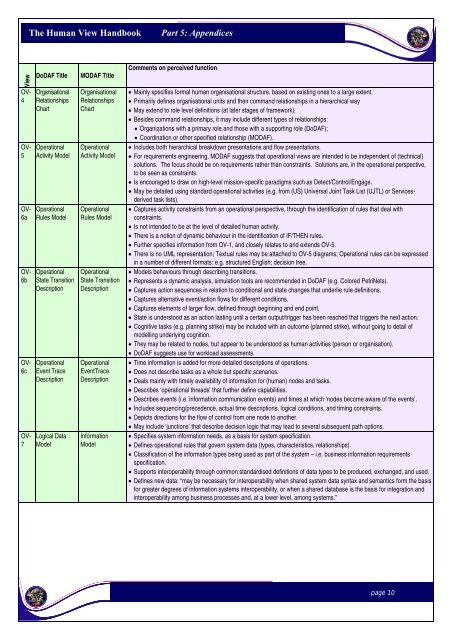The Human View Handbook for MODAF: Part V â Appendices
The Human View Handbook for MODAF: Part V â Appendices
The Human View Handbook for MODAF: Part V â Appendices
You also want an ePaper? Increase the reach of your titles
YUMPU automatically turns print PDFs into web optimized ePapers that Google loves.
<strong>The</strong> <strong>Human</strong> <strong>View</strong> <strong>Handbook</strong><br />
<strong>Part</strong> 5: <strong>Appendices</strong><br />
<strong>View</strong><br />
OV-<br />
4<br />
OV-<br />
5<br />
OV-<br />
6a<br />
OV-<br />
6b<br />
OV-<br />
6c<br />
OV-<br />
7<br />
DoDAF Title<br />
Organisational<br />
Relationships<br />
Chart<br />
Operational<br />
Activity Model<br />
Operational<br />
Rules Model<br />
Operational<br />
State Transition<br />
Description<br />
Operational<br />
Event Trace<br />
Description<br />
Logical Data<br />
Model<br />
<strong>MODAF</strong> Title<br />
Organisational<br />
Relationships<br />
Chart<br />
Operational<br />
Activity Model<br />
Operational<br />
Rules Model<br />
Operational<br />
State Transition<br />
Description<br />
Operational<br />
EventTrace<br />
Description<br />
In<strong>for</strong>mation<br />
Model<br />
Comments on perceived function<br />
• Mainly specifies <strong>for</strong>mal human organisational structure, based on existing ones to a large extent.<br />
• Primarily defines organisational units and their command relationships in a hierarchical way<br />
• May extend to role level definitions (at later stages of framework).<br />
• Besides command relationships, it may include different types of relationships:<br />
• Organizations with a primary role and those with a supporting role (DoDAF);<br />
• Coordination or other specified relationship (<strong>MODAF</strong>).<br />
• Includes both hierarchical breakdown presentations and flow presentations.<br />
• For requirements engineering, <strong>MODAF</strong> suggests that operational views are intended to be independent of (technical)<br />
solutions. <strong>The</strong> focus should be on requirements rather than constraints. Solutions are, in the operational perspective,<br />
to be seen as constraints.<br />
• Is encouraged to draw on high-level mission-specific paradigms such as Detect/Control/Engage.<br />
• May be detailed using standard operational activities (e.g. from (US) Universal Joint Task List (UJTL) or Servicesderived<br />
task lists).<br />
• Captures activity constraints from an operational perspective, through the identification of rules that deal with<br />
constraints.<br />
• Is not intended to be at the level of detailed human activity.<br />
• <strong>The</strong>re is a notion of dynamic behaviour in the identification of IF/THEN rules.<br />
• Further specifies in<strong>for</strong>mation from OV-1, and closely relates to and extends OV-5.<br />
• <strong>The</strong>re is no UML representation; Textual rules may be attached to OV-5 diagrams; Operational rules can be expressed<br />
in a number of different <strong>for</strong>mats: e.g. structured English; decision tree.<br />
• Models behaviours through describing transitions.<br />
• Represents a dynamic analysis, simulation tools are recommended in DoDAF (e.g. Colored PetriNets).<br />
• Captures action sequences in relation to conditional and state changes that underlie rule definitions.<br />
• Captures alternative event/action flows <strong>for</strong> different conditions.<br />
• Captures elements of larger flow, defined through beginning and end point.<br />
• State is understood as an action lasting until a certain output/trigger has been reached that triggers the next action.<br />
• Cognitive tasks (e.g. planning strike) may be included with an outcome (planned strike), without going to detail of<br />
modelling underlying cognition.<br />
• <strong>The</strong>y may be related to nodes, but appear to be understood as human activities (person or organisation).<br />
• DoDAF suggests use <strong>for</strong> workload assessments.<br />
• Time in<strong>for</strong>mation is added <strong>for</strong> more detailed descriptions of operations.<br />
• Does not describe tasks as a whole but specific scenarios.<br />
• Deals mainly with timely availability of in<strong>for</strong>mation <strong>for</strong> (human) nodes and tasks.<br />
• Describes ‘operational threads’ that further define capabilities.<br />
• Describes events (i.e. in<strong>for</strong>mation communication events) and times at which ‘nodes become aware of the events’.<br />
• Includes sequencing/precedence, actual time descriptions, logical conditions, and timing constraints.<br />
• Depicts directions <strong>for</strong> the flow of control from one node to another.<br />
• May include ‘junctions’ that describe decision logic that may lead to several subsequent path options.<br />
• Specifies system in<strong>for</strong>mation needs, as a basis <strong>for</strong> system specification.<br />
• Defines operational rules that govern system data (types, characteristics, relationships).<br />
• Classification of the in<strong>for</strong>mation types being used as part of the system – i.e. business in<strong>for</strong>mation requirements<br />
specification.<br />
• Supports interoperability through common standardised definitions of data types to be produced, exchanged, and used.<br />
• Defines new data: “may be necessary <strong>for</strong> interoperability when shared system data syntax and semantics <strong>for</strong>m the basis<br />
<strong>for</strong> greater degrees of in<strong>for</strong>mation systems interoperability, or when a shared database is the basis <strong>for</strong> integration and<br />
interoperability among business processes and, at a lower level, among systems.”<br />
page 10
















